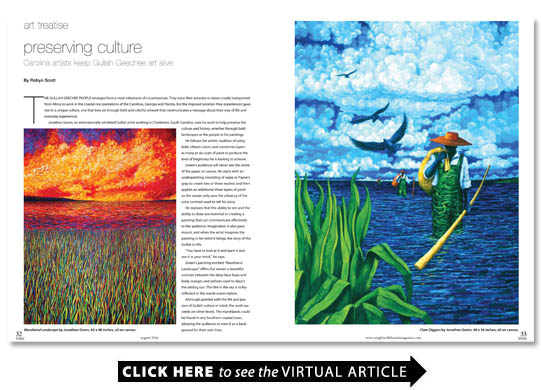Preserving Culture
BY Robyn Scott
The Gullah Geechee people emerged from a most inhumane of circumstances. They trace their ancestry to slaves cruelly transported from Africa to work in the coastal rice plantations of the Carolinas Georgia and Florida. But the imposed isolation they experienced gave rise to a unique culture one that lives on through bold and colorful artwork that communicates a message about their way of life and everyday experiences.
Jonathan Green an internationally exhibited Gullah artist working in Charleston South Carolina uses his work to help preserve the culture and history whether through bold landscapes or the people in his paintings.
He follows the artistic tradition of using bold vibrant colors and sometimes layers as many as six coats of paint to produce the level of brightness he is looking to achieve.
Green’s audience will never see the white of the paper or canvas. He starts with an underpainting consisting of sepia or Payne’s gray to create two or three washes and then applies an additional three layers of paint so the viewer only sees the vibrancy of the color contrast used to tell his story.
He explains that the ability to see and the ability to draw are essential to creating a painting that can communicate effectively to the audience. Imagination is also paramount and when the artist imagines the painting in his mind it brings the story of the Gullah to life.
“You have to look at it and learn it and see it in your mind ” he says.
Green’s painting entitled “Marshland Landscape” offers the viewer a beautiful contrast between the deep blue hues and lively oranges and yellows used to depict the setting sun. This fire in the sky is richly reflected in the marsh waters below.
Although painted with the life and passion of Gullah culture in mind the work succeeds on other levels. The marshlands could be found in any Southern coastal town allowing the audience to view it as a background for their own lives.
“Carrying the Shade” is another representation of exciting color usage. In this work Green uses acrylic on watercolor paper thick enough to hold up to his multiple layers of paint. The crimson red of the umbrella brings the eye’s attention directly to the focal point the girl carrying it and provides a contrast to the softer blue sky in the background. Once again the viewer sees the marshlands that are ever-present in this region also reminiscent of the rice plantations.
“Leaving Beaufort ” also acrylic on paper is another strong representation of the Gullah style. Bright yellow seeps through the background trees to produce the sunlit effect that Carolinians witness as the breeze moves gently through the trees in the summer and fall. A lady in a bright-blue patterned dress waves goodbye to a friend leaving Beaufort. The friend is only a small silhouette against the bright-yellow sky leaving the lady’s dress to be the grand focus of this work. The great attention to detail in the pattern tells the viewer that her gown is of the utmost importance. The deep-blue shades provide yet another high contrast to the intense yellow Southern sky.
On South Carolina’s Hilton Head Island another cultural artist Sonja Griffin Evans depicts the spirituality and beauty of Gullah tradition in her paintings.
Ideas come to her quickly so she uses acrylic paint for its color saturation and fast-drying quality. In addition to the signature bold colors found in most Gullah art she utilizes texture and found objects in her work. Evans uses jewel tones and incorporates various construction materials found in and around her town into her paintings. They produce a hybrid between a painting and a sculpture that invites the viewer to look closer and hear her message.
“God opens up many doors and I paint them ” she says. “At any moment in time all you have to do is reach out and open that door.”
This is the perfect explanation of her series entitled “Inspirational Doors.” These works are painted on canvas with written text from significant points in time from the Gullah culture.
The “Inspirational Doors” series incorporates found objects as part of the overall composition. Real door hinges and knobs offer a tactile element that brings the viewer closer to the reality of slavery in the United States providing a powerful form of communication.
“Harvesting Corn” is another multimedia work. Evans used a sheet of tin and a corn sifter as a canvas for her painting of a man whom she calls Mr. Zeke harvesting corn . This piece merges a colorful depiction of a corn harvester with a literal one and fuses these two parts of the Gullah culture together. “Harvesting Corn” displays the plight of the sharecroppers who struggled to work among dishonest landlords in the post-Civil War era.
“Freedom Dance” depicts the antithesis of the plight experienced by men like Mr. Zeke. Women in colorful dresses joyfully swirl in celebration of liberty. Evans says the painting is set in Mitchelville a town built during the Civil War for escaped slaves located on what is now Hilton Head Island. In 1862 shortly after the Emancipation Proclamation was signed the people of Mitchelville were free to create a new self-governed culture.
“Abe’s 506” exhibits the classic bright color scheme used in many Gullah paintings. Ladies in jewel-toned dresses contrast the black and white suits of the gentlemen. A bright blue monotone background allows the viewer’s eye to move around the canvas focusing on each person for just a few seconds. The audience can imagine the subjects talking and moving throughout the composition.
These animated depictions of line and color shine a vibrant light onto Gullah painting and culture.
